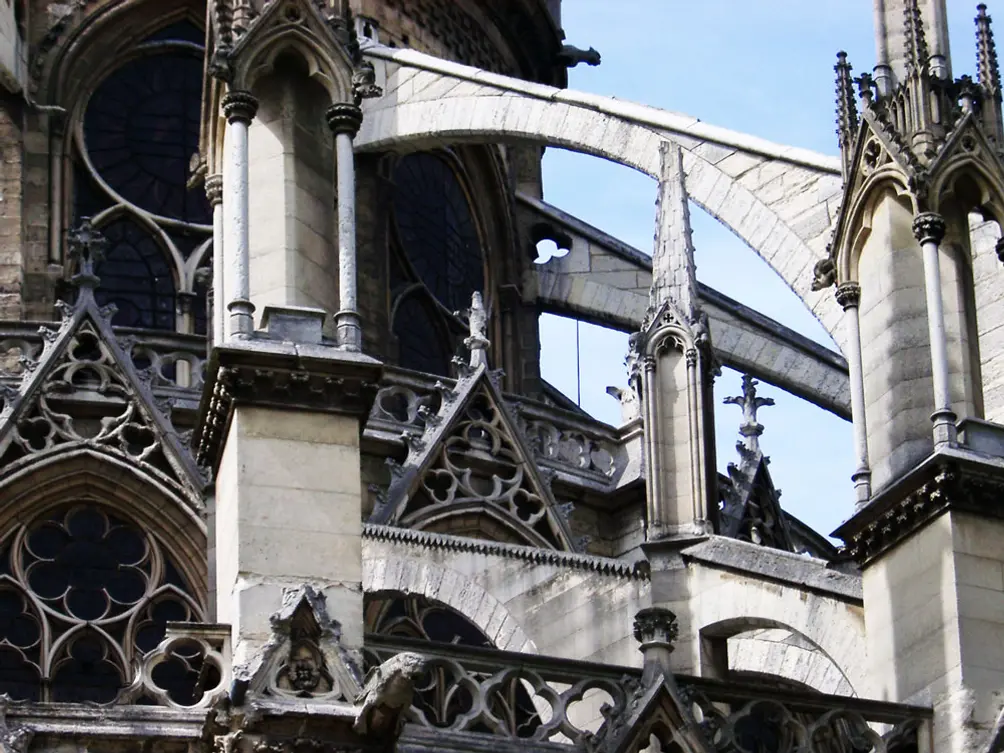 Flying buttresses on the Notre Dame
Flying buttresses on the Notre Dame
The city has a few flying buttresses but they are, with rare exception, not highly visible if your drone’s battery has run down.
Flying buttresses, of course, are among the most flamboyant architectural flourishes that were created in the Gothic Age to permit large churches to have enormous walls of stained glass. They are angled supports and generally they are up in the air, perched on setbacks and sometimes on their own very thick and sturdy walls, or posts.
They are sort of like a spider's legs, spindly, utilitarian appendages that are often bent and bereft of serious sculptural decoration.
They are usually placed symmetrically at the sides of great naves, but also sometimes around the back of them as well.
While it is the steeple/belltower, entrance doors and gargoyles and stained glass windows that get the most attention in churches, their flying buttresses have a rather independent dynamic. Churches tend to be large, cumbersome, albeit often beautiful, structures that convey a great sense of lasting permanence and heaviness. Flying buttresses, on the other hand, convey great tension and conjure motion, like an archer's bow.
They are, in fact, the epitome of deconstruction, not in the late 20th Century sense of askew, a-kilter asymmetry that is meant to confuse, challenge and upset the viewer because it is not neat but radical, but in the pre-scientific world of mystical power, of omnipotent architecture in which every element is energized.
But in New York City flying buttresses don't compete with the traditional syncopated line-up of many Rockettes and tend to act solo, or in pairs. The closest New Yorkers will ever get to see traditional home-grown flying buttresses may be at Santiago Calatrava's Transportation Hub, recently completed at Ground Zero and where he initially planned an openable, ribbed roof -- quite literal flying buttresses, except that they were not holding up anything. Calatrava's great scheme to complete The Cathedral Church of St. John The Divine at 112th Street also called for some spectacular struts around the apse that might have become modern-day, flying buttresses but that superb plan unfortunately lost its financing legs a few years ago.
For 20th Century buildings, such structural elements are not there for engineering support. They are hiding something. They are tidy disguises for fireplace flues. While Europe abounds in pipe-covered old, pre-plumbing buildings, New York abhors messy architecture and generally wants its chimneys in clusters. A proper chimney can't release its smoke on someone's terrace but since many fireplaces were placed in outside walls their flues often need to be angled to avoid choking the penthouses.
Flying buttresses, of course, are among the most flamboyant architectural flourishes that were created in the Gothic Age to permit large churches to have enormous walls of stained glass. They are angled supports and generally they are up in the air, perched on setbacks and sometimes on their own very thick and sturdy walls, or posts.
They are sort of like a spider's legs, spindly, utilitarian appendages that are often bent and bereft of serious sculptural decoration.
They are usually placed symmetrically at the sides of great naves, but also sometimes around the back of them as well.
While it is the steeple/belltower, entrance doors and gargoyles and stained glass windows that get the most attention in churches, their flying buttresses have a rather independent dynamic. Churches tend to be large, cumbersome, albeit often beautiful, structures that convey a great sense of lasting permanence and heaviness. Flying buttresses, on the other hand, convey great tension and conjure motion, like an archer's bow.
They are, in fact, the epitome of deconstruction, not in the late 20th Century sense of askew, a-kilter asymmetry that is meant to confuse, challenge and upset the viewer because it is not neat but radical, but in the pre-scientific world of mystical power, of omnipotent architecture in which every element is energized.
But in New York City flying buttresses don't compete with the traditional syncopated line-up of many Rockettes and tend to act solo, or in pairs. The closest New Yorkers will ever get to see traditional home-grown flying buttresses may be at Santiago Calatrava's Transportation Hub, recently completed at Ground Zero and where he initially planned an openable, ribbed roof -- quite literal flying buttresses, except that they were not holding up anything. Calatrava's great scheme to complete The Cathedral Church of St. John The Divine at 112th Street also called for some spectacular struts around the apse that might have become modern-day, flying buttresses but that superb plan unfortunately lost its financing legs a few years ago.
For 20th Century buildings, such structural elements are not there for engineering support. They are hiding something. They are tidy disguises for fireplace flues. While Europe abounds in pipe-covered old, pre-plumbing buildings, New York abhors messy architecture and generally wants its chimneys in clusters. A proper chimney can't release its smoke on someone's terrace but since many fireplaces were placed in outside walls their flues often need to be angled to avoid choking the penthouses.
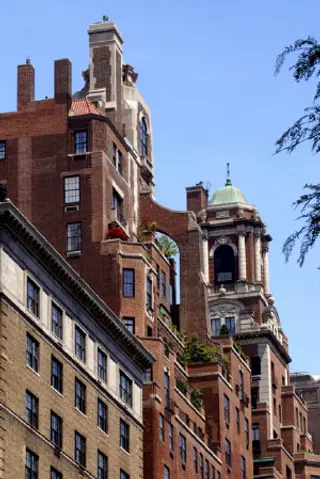 770 Park Avenue
770 Park Avenue
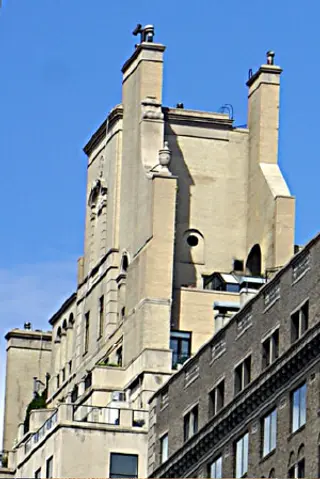 1040 5th Avenue
1040 5th Avenue
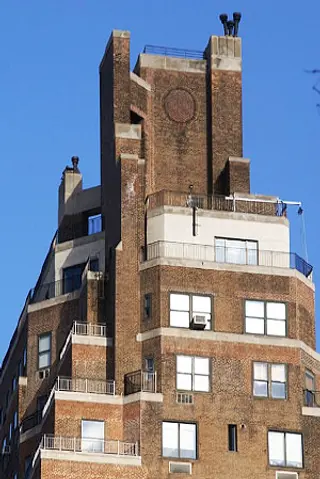 49 East 86th Street
49 East 86th Street
Walk around 4 East 72nd Street, 770 Park Avenue, 49 East 86th Street, 12 East 88th Street, 19 East 89th Street and 1040 Fifth Avenue, however, for some special New York City flying buttress examples. High up, you'll find some setbacks with some arched openings, mostly curved except for 49 East 86th Street.
New York’s flying buttresses cannot hold a candle to some of their European counterparts.
Probably the best known flying buttresses can be found at Notre-Dame in Paris where they seem to have encircled the back of the church and captured it in a very large net that tethers it and its twin towers to the ground frustrating some of its gargoyles who seem to want to fly away with them.
The Strasbourg Cathedral has some substantial flying buttresses that have circular openings near their tops that are similar in design to those at Notre-Dame but not as graceful.
The Cologne Cathedral buttresses have six quatrefoil openings and their tops are lined with small finials.
The cathedral in Chartres has some scrawny but large, bent buttresses whose minimalism is puzzling given the glorious explosion of colors they support within.
Shortly after construction began on the cathedral in Chartres, work began on a cathedral in Rouen that also employed flying buttresses but with bigger and more awkward proportions. It took a few hundred years for the cathedral to be finished and its overall composition suffered considerably by the delays and perhaps that is why Monet concentrated his famous series of paintings of it on its deep and richly detailed portal.
Westminster Cathedral has some very ornate buttresses with multiple arcs and circles and quatrefoils in a quite musical and robust composition. Those at York Cathedral, on the other hand, only have arcs on their undersides but they conjure grand jetes. At the Cathedral of Notre-Dame in Reims, France, similar buttresses are double-tiered.
At St. George's Chapel at Windsor Castle the buttresses form a very elegant, formal exoskeleton. Supposedly the earliest flying buttresses were employed at the Basilique Saint Denis in Paris. In an age when some daredevils tightrope-walk between tall towers and scale some others, flying buttresses might not seem much of a challenge, but steering one’s drones through them might be and perhaps the city should consider sponsoring races much like the ones held in the early days of aviation.
New York’s flying buttresses cannot hold a candle to some of their European counterparts.
Probably the best known flying buttresses can be found at Notre-Dame in Paris where they seem to have encircled the back of the church and captured it in a very large net that tethers it and its twin towers to the ground frustrating some of its gargoyles who seem to want to fly away with them.
The Strasbourg Cathedral has some substantial flying buttresses that have circular openings near their tops that are similar in design to those at Notre-Dame but not as graceful.
The Cologne Cathedral buttresses have six quatrefoil openings and their tops are lined with small finials.
The cathedral in Chartres has some scrawny but large, bent buttresses whose minimalism is puzzling given the glorious explosion of colors they support within.
Shortly after construction began on the cathedral in Chartres, work began on a cathedral in Rouen that also employed flying buttresses but with bigger and more awkward proportions. It took a few hundred years for the cathedral to be finished and its overall composition suffered considerably by the delays and perhaps that is why Monet concentrated his famous series of paintings of it on its deep and richly detailed portal.
Westminster Cathedral has some very ornate buttresses with multiple arcs and circles and quatrefoils in a quite musical and robust composition. Those at York Cathedral, on the other hand, only have arcs on their undersides but they conjure grand jetes. At the Cathedral of Notre-Dame in Reims, France, similar buttresses are double-tiered.
At St. George's Chapel at Windsor Castle the buttresses form a very elegant, formal exoskeleton. Supposedly the earliest flying buttresses were employed at the Basilique Saint Denis in Paris. In an age when some daredevils tightrope-walk between tall towers and scale some others, flying buttresses might not seem much of a challenge, but steering one’s drones through them might be and perhaps the city should consider sponsoring races much like the ones held in the early days of aviation.
The very beautiful St. Patrick's Roman Catholic Cathedral on Fifth Avenue hides its relatively small flying buttresses on its roof which are best seen from the observatory at 30 Rockefeller Plaza.
No great city should be shy about its buttresses and the buttresses should be distinctive rather than discrete, awesome rather than awful, puzzling and proud for they are the stepping stones for our beloved gargoyles.
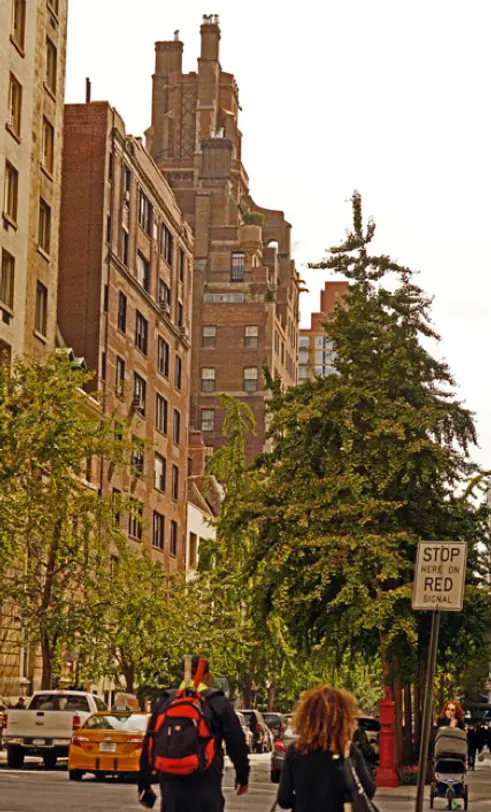 133 East 80th Street
133 East 80th Street
The very handsome apartment building at 133 East 80th Street boasts some fine gargoyles and one flying buttress. It is on one of the city’s grandest townhouse streets.
In olden days a bit of ornament was not considered shocking and perhaps today a gratuitous buttress to nowhere in particular might not be considered totally superfluous: not a traditional building amenity but a dashing, if not darting, distinctive element of character and personality.
What a city always need is grand gestures – flying buttresses, or whatever….
In olden days a bit of ornament was not considered shocking and perhaps today a gratuitous buttress to nowhere in particular might not be considered totally superfluous: not a traditional building amenity but a dashing, if not darting, distinctive element of character and personality.
What a city always need is grand gestures – flying buttresses, or whatever….

Architecture Critic
Carter Horsley
Since 1997, Carter B. Horsley has been the editorial director of CityRealty. He began his journalistic career at The New York Times in 1961 where he spent 26 years as a reporter specializing in real estate & architectural news. In 1987, he became the architecture critic and real estate editor of The New York Post.

 6sqft delivers the latest on real estate, architecture, and design, straight from New York City.
6sqft delivers the latest on real estate, architecture, and design, straight from New York City.
